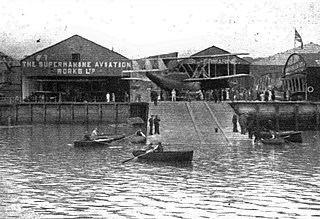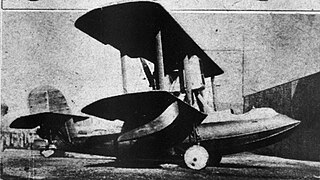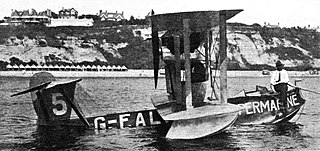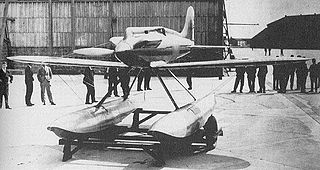
Supermarine was a British aircraft manufacturer. It is most famous for producing the Spitfire fighter plane during World War II. It also built a range of seaplanes and flying boats, winning the Schneider Trophy for seaplanes with three wins in a row in 1927, 1929 and 1931. After the war, the company produced a series of jet fighters.

Reginald Joseph Mitchell was a British aircraft designer who worked for the Southampton aviation company Supermarine from 1916 until 1936. He is best known for designing racing seaplanes such as the Supermarine S.6B, and for leading the team that designed the Supermarine Spitfire.

The Coupe d'Aviation Maritime Jacques Schneider, also known as the Schneider Trophy, Schneider Prize or (incorrectly) the Schneider Cup is a trophy that was awarded first annually, and later biennially, to the winner of a race for seaplanes and flying boats. In 1931 Britain met the conditions to retain the Trophy permanently; it was held at the Science Museum in South Kensington, London.

The Rolls-Royce R is a British aero engine that was designed and built specifically for air racing purposes by Rolls-Royce Limited. Nineteen R engines were assembled in a limited production run between 1929 and 1931. Developed from the Rolls-Royce Buzzard, it was a 37-litre capacity, supercharged V-12 capable of producing just under 2,800 horsepower (2,090 kW), and weighed 1,640 pounds (770 kg). Intensive factory testing revealed mechanical failures which were remedied by redesigning the components, greatly improving reliability.

Mario Castoldi was an Italian aircraft engineer and designer.

The Supermarine Scapa was a British general reconnaissance flying boat built by Supermarine that was used by the Royal Air Force between 1935 and 1939. It was developed from the Southampton and formed the basis of the Supermarine Stranraer.

The Supermarine S.6 is a 1920s British single-engined single-seat racing seaplane built by Supermarine and designed by its chief designer, R.J. Mitchell, who refined the earlier Supermarine S.5 to produce a larger, more powerful aircraft. Two aircraft, N247 and N248, were built to participate in the 1929 Schneider Trophy contest. Rolls-Royce produced the R engine for the new all-metal aircraft. The engine's initial issues—such as the short time between overhauls and the heat generated when the engine power was increased to 1,900 hp (1,400 kW)—were resolved within a few months before the aircraft were completed at Supermarine’s works at Woolston, Southampton.

The Supermarine S.4 was a 1920s British single-engined monoplane built by the company Supermarine. Designed by a team led by the company's chief designer, R. J. Mitchell, it was designed to compete in the 1925 Schneider Trophy contest.

Wing Commander George Hedley Stainforth, was a Royal Air Force pilot and the first man to exceed 400 miles per hour.
The Supermarine Type 224 was a British gull-wing monoplane fighter aircraft designed by R.J. Mitchell at Supermarine in response to Air Ministry Specification F.7/30, which sought to introduce a new fighter to succeed the Gloster Gauntlet. The Type 224 was powered by a Rolls-Royce Goshawk engine, which used an experimental evaporative cooling system.

The Supermarine S.5 was a 1920s British single-engined single-seat racing seaplane built by Supermarine. Designed specifically for the Schneider Trophy competition, the S.5 was the progenitor of a line of racing aircraft that ultimately led to the iconic Supermarine Spitfire fighter of the Second World War

The Supermarine Sea Lion II was a British racing flying boat built by the Supermarine Aviation Works. Designed by Reginald Mitchell, the Sea Lion II was a modification of Supermarine's Sea King II. It was powered by a 450 hp (340 kW) Napier Lion engine.

The Supermarine Sea Lion I was a British racing flying boat designed and built by Supermarine for the Schneider Trophy contest at Bournemouth, England, in September 1919. It was based on a version of the Supermarine Baby, the first single-seat flying boat fighter aircraft to be designed and built in the United Kingdom, that first flew in February 1918.

The Supermarine Sea Lion III was a British racing flying boat built by the Supermarine Aviation Works. Designed by Reginald Mitchell, it was a modification of Supermarine's Supermarine Sea Lion II. It was powered by a 550 hp (410 kW) Napier Lion engine.

The Supermarine Sea King was a British single-seat amphibious biplane fighter designed by Supermarine in 1919. Developed from the Supermarine Baby and the Supermarine Sea Lion I, the Sea King was a single seater biplane powered by a pusher 160 horsepower (120 kW) Beardmore engine. It first flew in early 1920 and was exhibited by Supermarine at the 1920 Olympia Show in London. The company released drawings of the aircraft's design prior to the show; what it exhibited was probably a modified Supermarine Baby.

The Supermarine Baby was a First World War fighter aircraft that was the earliest example of a single-seat flying boat fighter to be built in the United Kingdom. It was designed by Supermarine to meet a 1917 Navy Board specification which stipulated the aircraft have a speed of 95 knots, a ceiling of 20,000 feet (6,100 m), and be capable of being launched from ships at sea. When it first flew in February 1918 it was one of the smallest and fastest flying boats then in existence.

The RAF High Speed Flight, sometimes known as 'The Flight' , was a small flight of the Royal Air Force (RAF) formed for the purpose of competing in the Schneider Trophy contest for racing seaplanes during the 1920s. The flight was together only until the trophy was won outright, after which it was disbanded.

Solent Sky is an aviation museum in Southampton, England.

Henry Richard Danvers Waghorn, was a British aviator and Royal Air Force officer who flew the winning aircraft in the 1929 Schneider Trophy seaplane race.

Henry Biard was a British pilot and aircraft racer. As chief test pilot for the British aircraft manufacturer Supermarine, he won the 1922 Schneider Trophy air race and briefly held the world record for the fastest speed in a seaplane.























